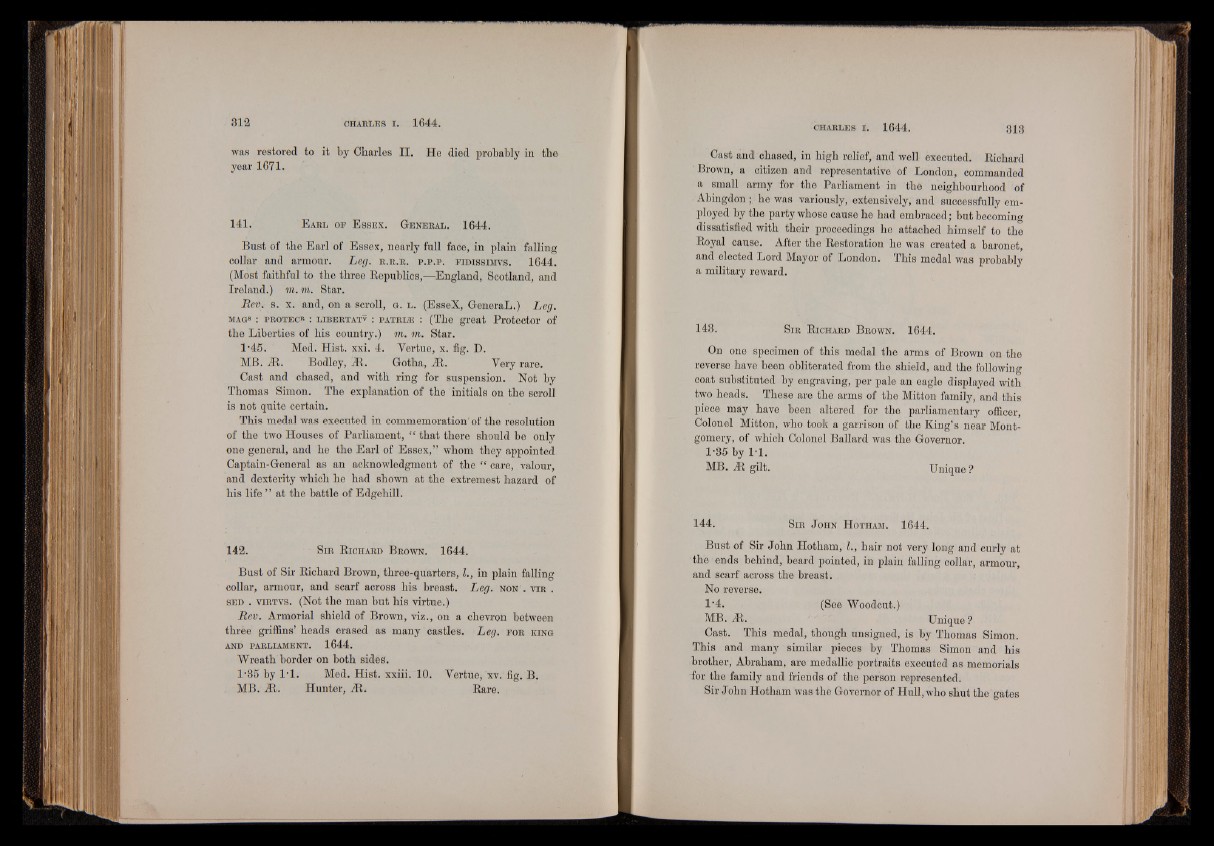
was restored to it by Charles II. He died probably in the
year 1671.
141. E arl o p E s s e x . G e n e r a l . 1644.
Bust of the Earl of Essex, nearly full face, in plain falling
collar and armour. Leg. r .r .r . p .p .p . f id is s im v s . 1644.
(Most faithful to the three Republics,—England, Scotland, and
Ireland.) m. m. Star.
Rev. s. x. and, on a scroll, g . l . (EsseX, GeneraL.) Leg.
mag8 : pr o t e c r : l ib e r ta tv : pa t r l e : (The great Protector of
the Liberties of his country.) m. m. Star.
1‘46. Med. Hist. xxi. 4. Vertue, x. fig. D.
MB. JR. Bodley, jR. Gotha, JR. Very rare.
Cast and chased, and with ring for suspension. Not by
Thomas Simon. The explanation of the initials on the scroll
is not quite certain.
This medal was executed in commemoration'of the resolution
of the two Houses of Parliament, “ that there should be only
one general, and he the Earl of Essex,” whom they appointed.
Captain-General as an acknowledgment of the “ care, valour,
and dexterity which he had shown at the extremest hazard of
his life ” at the battle of Edgehill.
142. S ir R ic h a r d B row n . 1644.
Bust of Sir Richard Brown, three-quarters, I., in plain falling
collar, armour, and scarf across his breast. Leg. non . v ir .
bed . v ir t v s . (Not the man but his virtue.)
jRev. Armorial shield of Brown, viz., on a chevron between
three griffins’ heads erased as many castles. Leg. fo r k in g
AND PARLIAMENT. 1644.
"Wreath border on both sides.
1‘35 by l 'l : Med. Hist, xxiii. 10. Vertue, xv. fig. B.
MB. JR. Hunter, JR. Rare.
Cast and chased, in high relief, and well executed. Richard
Brown, a citizen and representative of London, commanded
a small army for the Parliament in the neighbourhood of
Abingdon; he was variously, extensively, and successfully employed
by the party whose cause he had embraced; but becoming
dissatisfied with their proceedings he attached himself to the
Royal cause. After the Restoration he was created a baronet,
and elected Lord Mayor of London. This medal was probably
a military reward.
143. S ir R ic h a r d B row n . 1644.
On one specimen of this medal the arms of Brown on the
reverse have been obliterated from the shield, and the following
coat substituted by engraving, per pale an eagle displayed with
two heads. These are the arms of the Mitton family, and this
piece may have been altered for the parliamentary officer,
Colonel Mitton, who took a garrison of the King’s near Montgomery,
of which Colonel Ballard was the Governor.
1-35 by 1-1.
MB. JR gilt. Unique ?
144. S ir J ohn H o tham . 1644.
Bust of Sir John Hotham, I., hair not very long and curly at
the ends behind, beard pointed, in plain falling collar, armour,
and scarf across the breast.
No reverse.
1*4. (See Woodcut.)
MB. JR. Unique ?
Cast. This medal, though unsigned, is by Thomas Simon.
This and many similar pieces by Thomas Simon and his
brother, Abraham, are medallic portraits executed as memorials
for the family and friends of the person represented.
Sir John Hotham was the Governor of Hull, who shut the gates